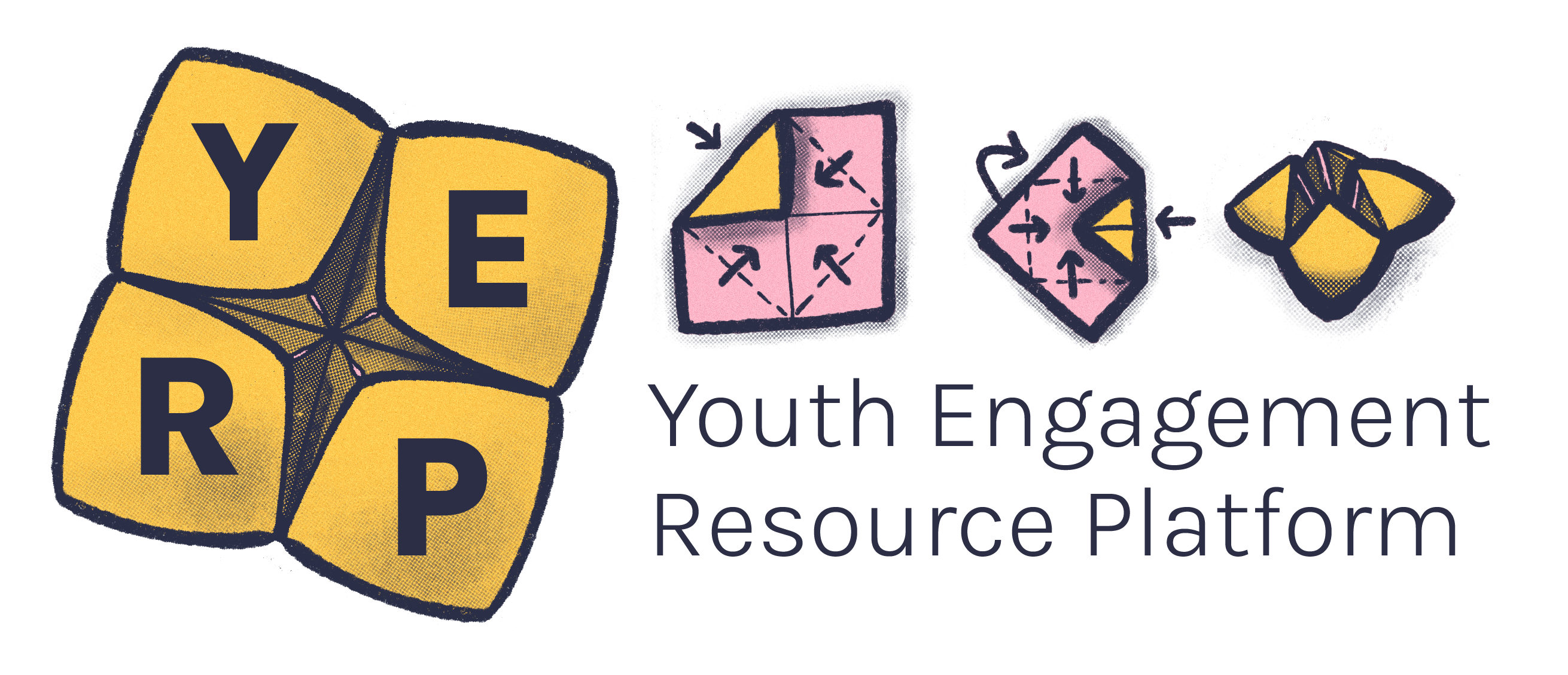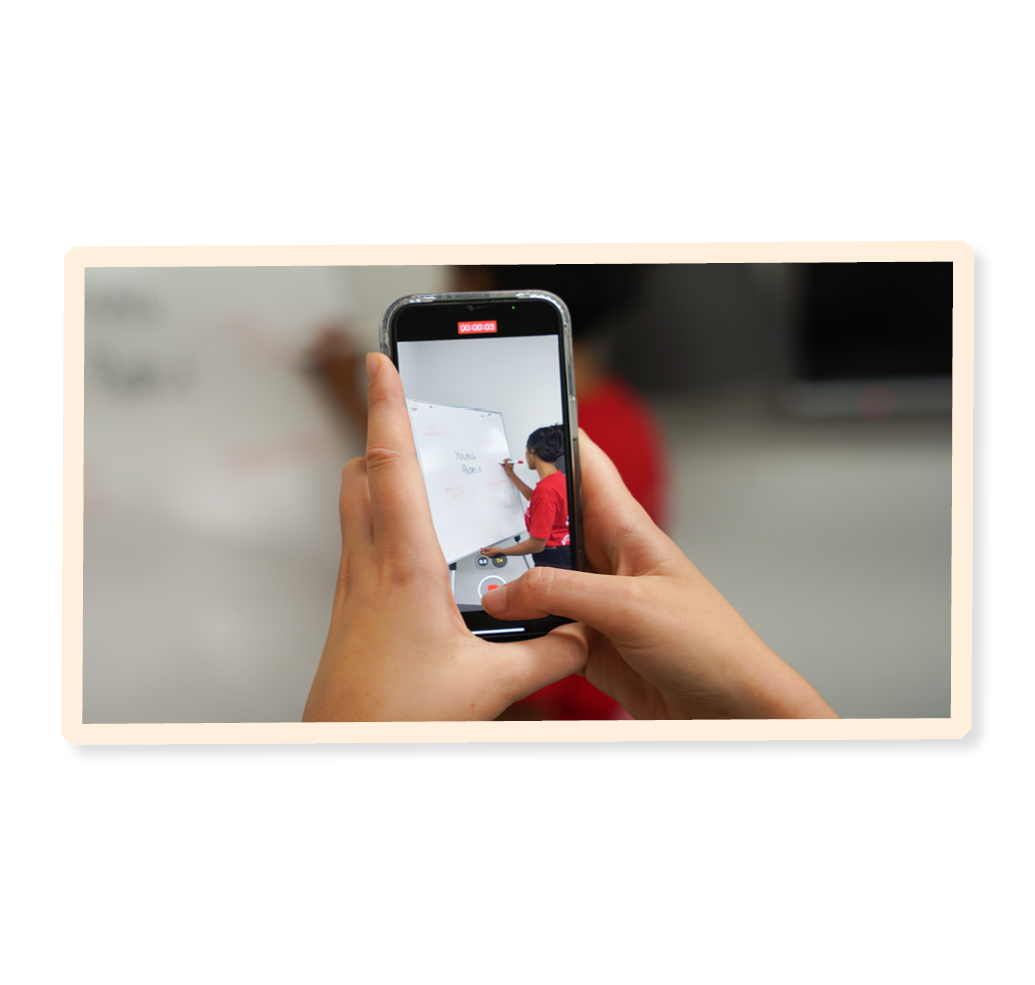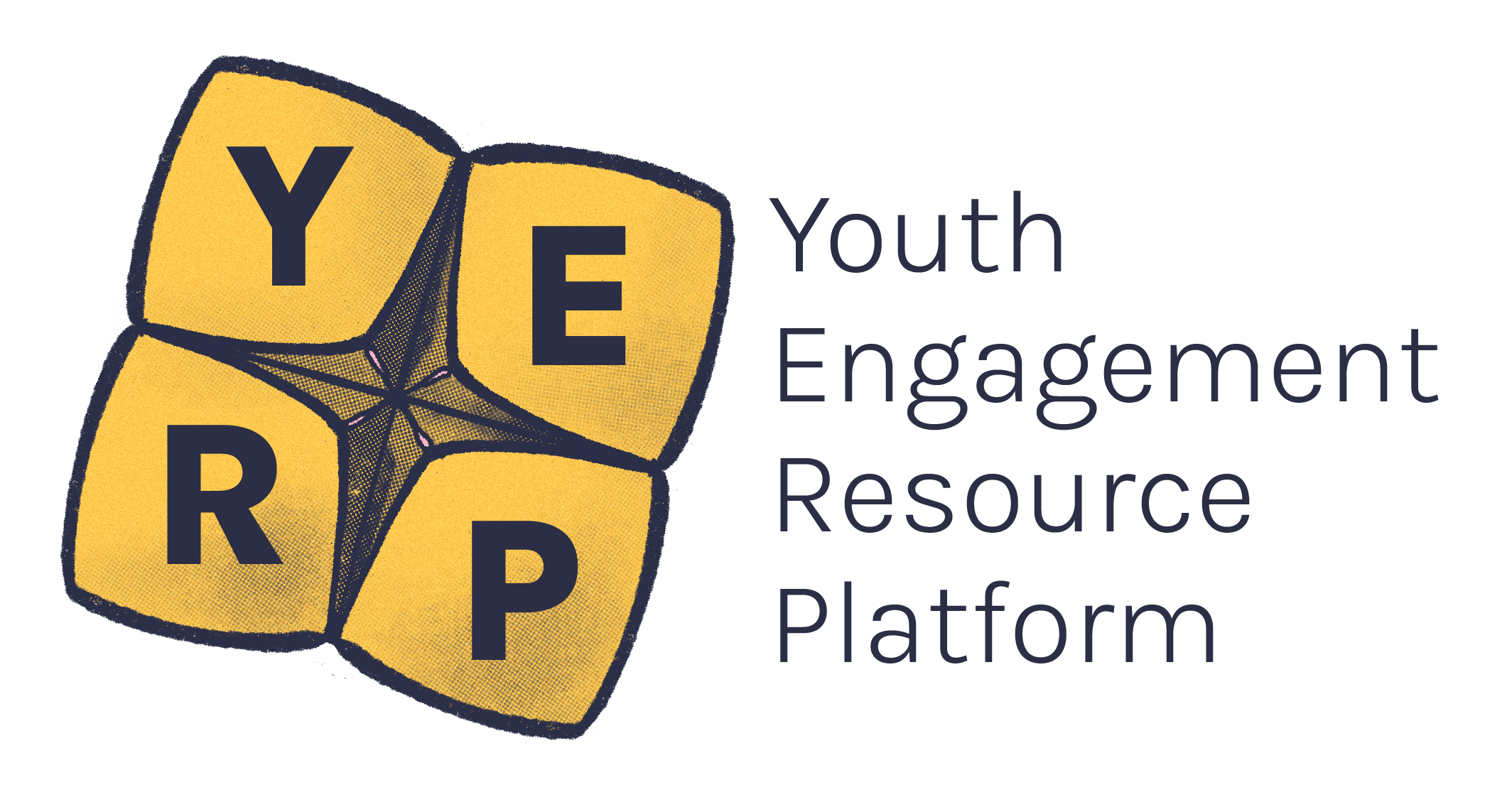Put simply, giving consent means giving permission for something to happen.
Consent can be given in any way that is accessible for you, but best practice is to use a written consent form that is signed and can be kept on file.
To be valid, consent needs to be informed, freely given or voluntary, specific and current.
Let’s break those individual elements down...
Informed consent
Being informed means you’ve received all necessary information and understand it before making a decision. You understand the situation, and the benefits or consequences of taking part.1,4,5
Voluntary consent
When consent is freely given or voluntary, it means you have made the choice to engage or to not engage all on your own. You have not been influenced by other people or pressures.4,5
Specific consent
Specific means the consent applies only for the information to be used for the purpose outlined, or to do one activity rather than multiple.5
Current consent
Current means the consent should be received in a timely manner, not so long ago that relevant circumstances or your views may reasonably have changed.5
This is an image of a person's hands, signing a form.
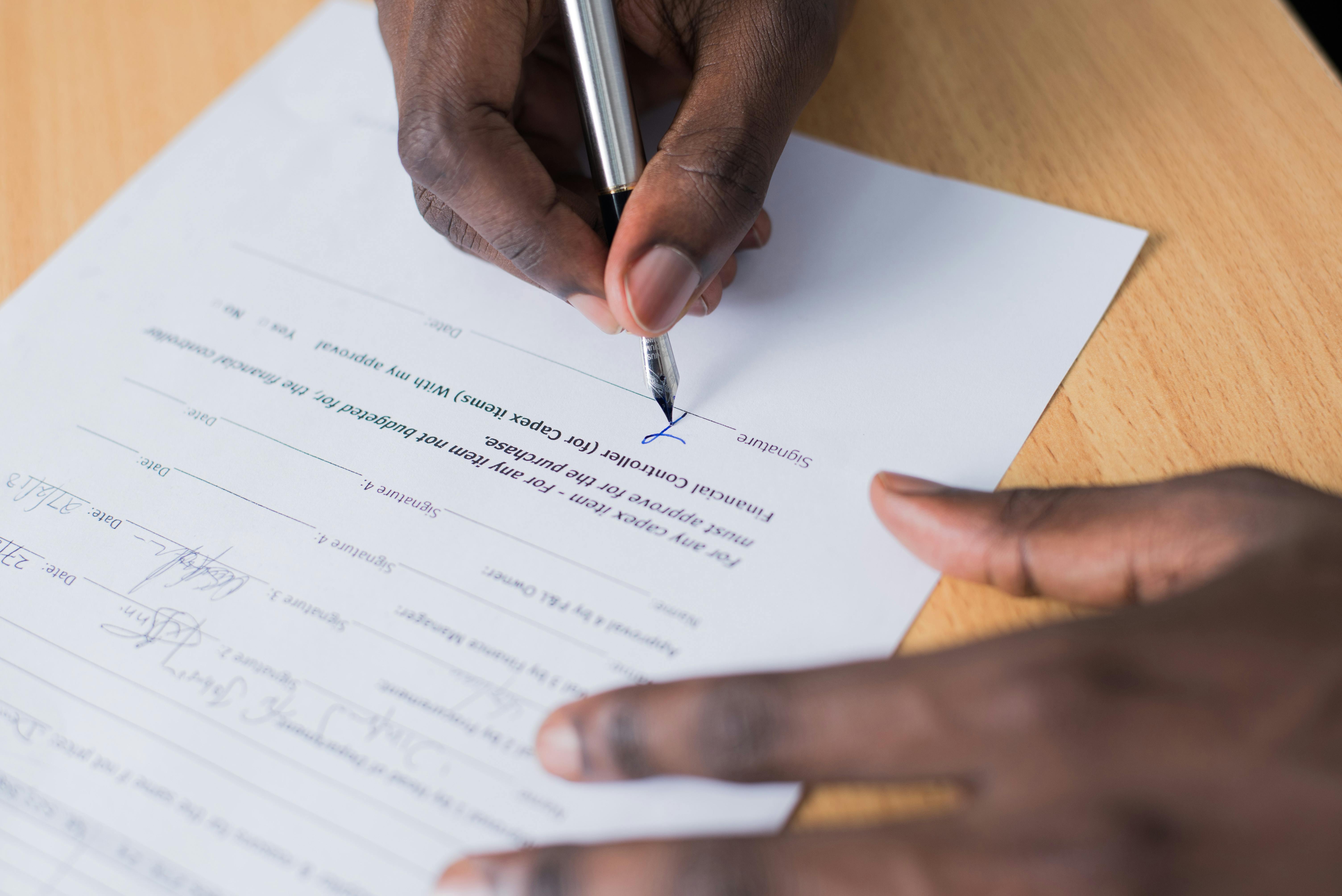
Depending on the context or situation you’re dealing with, there may be an age of consent. We recommend reading relevant legislation in this area.
Times you should be asked for your consent in formal settings:
- Before taking your image, whether a photograph, video or voice recording, and again if they want to publish it. Consent may be requested in the moment and if the photo is used a year later, consent should be sought again.2,3
- When using or exchanging your private information.
- Before going on an excursion.
- Before your involvement in a consultation or focus group.
- Before using your artwork or words.
- Before being interviewed by media.
Withdrawing consent
It’s important to know that you can withdraw your consent at any time and multiple times if necessary.5
Even if you give consent, you can ‘take it back’. If you withdraw your consent, an organisation or agency can’t rely on your past consent for any future use or disclosure of personal information.5
Context:
If someone has asked for your consent for something, they should be clear about how they will use the photograph, video, voice recording, artwork or other item that you have consented to share so that you have informed consent.2,3
If they haven’t been clear, make sure to ask questions until you fully understand what you’re consenting to.8
Storage:
If you have given your consent for something, it should be clearly explained where your information will be stored, how long it will be kept on file, and when it might be used publicly.2,7
YACVic recommends that materials are only used for five years, but there may be exceptions. Make sure to ask the organisation how long they plan to keep your information for.
Images should never be taken on personal devices. If someone tries to do this, tell them you aren’t comfortable with them taking it on a personal device and notify a trusted adult.2,8
If you’re under 16, you will need parental/carer's consent.
If you’re 16 and 17, parental/carer's consent may or may not be necessary depending on the activity and your individual circumstances. The person seeking your consent should know whether they need parental/carer's consent. If they decide this isn’t needed, they may still inform your parents or carer's that you’re taking part.
In most circumstances, parents have a legal parental responsibility for their children up until the age of 18.
Other reasons that someone might need your parental/carer's consent
If you don't fully understand what is being explained to you or the potential consequences of giving your consent.8 For example, not fully understanding the full risk of doing a tv interview, such as the potential to be trolled on social media afterwards.
In this case, a person may gain your parent or carer's consent in addition to yours. This way you're still actively involved in the decision about whether to take part, and you have support while doing so.
Please note that consent from you is not a replacement for parental consent. It is a way to empower you to be involved in the decision-making process.
There may be times where you want to take part in an event or program but there are some things you don’t want to share with certain people such as other group members or your parents.
You can let the people organising the event or program know what this information is, or you can request they provide you with a document where you can outline this.
Here's an example of a form you could ask to fill out so it can be kept on file:
A form for information people don't want made public.
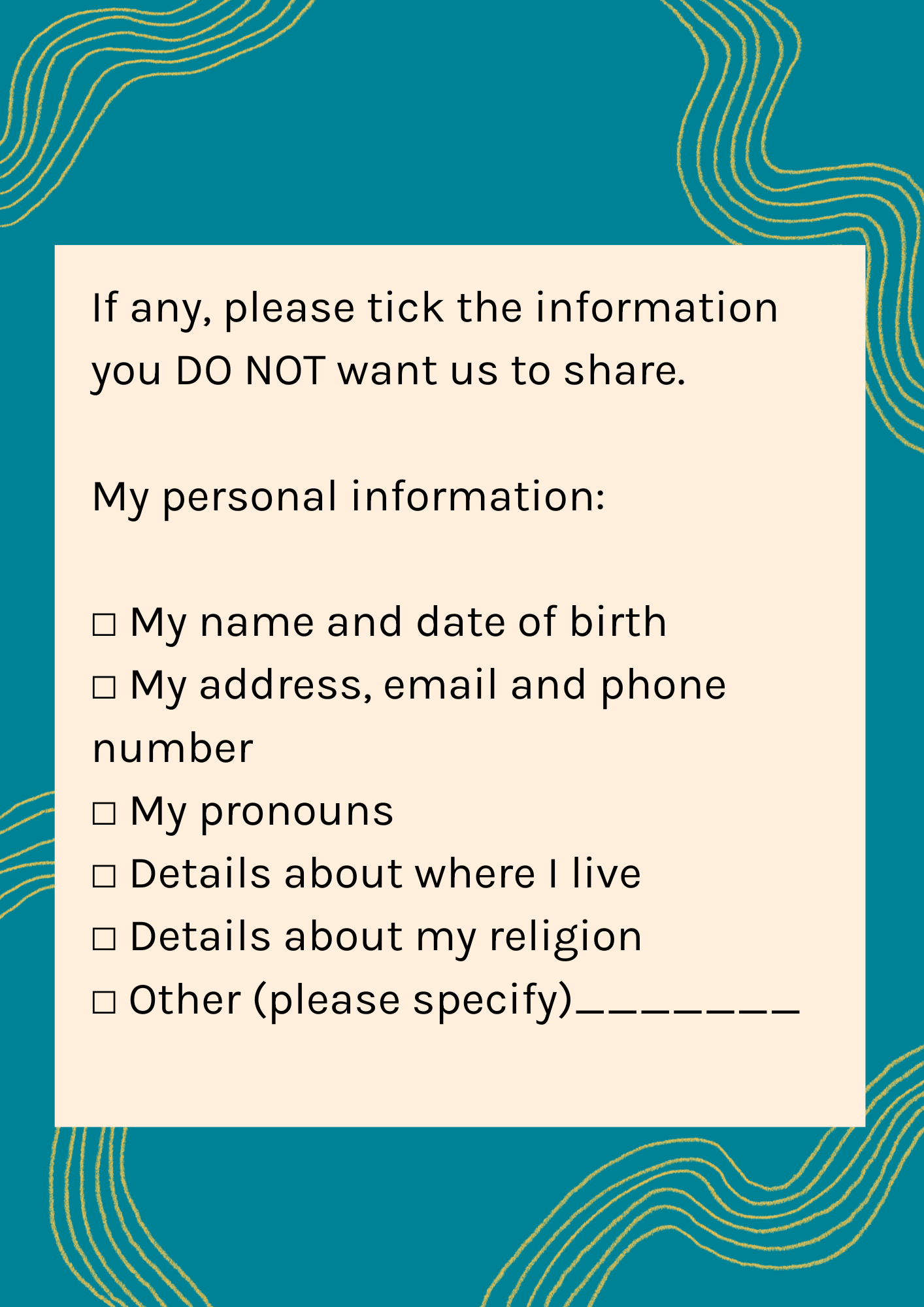
You should be provided different ways to give your consent. If the methods you've been given don’t work for you, ask for one that does.
As long as you provide the necessary information, in most cases consent can be given in any of the following ways:
- Filling out a consent form
- Via email
- Mailing a letter or form
- Voice recording/video recording
- Calling and giving consent over the phone
When working with adults, they have ethical responsibilities and legal obligations to your privacy. This includes a Workers will act in the best interests of young people, avoid exposing them to physical, psychological or emotional harm or injury, and always uphold the principle of ‘do no harm’.duty of care to protect your privacy and confidentiality.
Types of private information
Make sure to be aware of what private information looks like.
Personal information includes a broad range of information, or an opinion, that could identify you.6
For example:6
- Your name, signature, address, phone number or date of birth
- Financial information
- Photographs
- Location information from a mobile device (because it can reveal user activity patterns and habits)
Sensitive information is personal information that includes information or an opinion about your:6
- Racial or ethnic origin
- Political opinions or associations
- Religious or philosophical beliefs
- Trade union membership or associations
- Sexual orientation or practices
- Criminal record
- Health related information
Storing information
When people are handling personal or sensitive information, it must be stored in a secure and confidential way.7
You have the right to ask how your private information is being stored and handled.8
♫ Upbeat instrumental music plays in background ♫
Sam: Do I have to?
Young person: It's just a prick
Sam: [Ahhh] All right.
Doctor: Sam?
Sam: Wish me luck
Doctor: Have a seat
[door closes and locks]
Doctor: Sam, what do we have you in for today?
Sam: Just the flu shot
Doctor: Okay, [um], have you had any flu shots before?
Sam: No, I just kind of hate needles
Doctor: Well, then we'll just have a few questions for you before we get started.
Have you had any vaccinations in the last 6 months?
Sam: No
Doctor: Okay are you pregnant or do you have any pre-existing medical conditions?
Sam: No, but I do have asthma
Doctor: All right, and [um], okay everything looks fine here so do you have any questions for me before we get started?
Sam: No
Doctor: Okay, right or left arm?
Sam: Right
Doctor: All right that's it, you did a great job... there you go.
Sam: [Um] Okay, is there anything else I need to do?
Doctor: Well, it's entirely optional but in conjunction with the company that's producing the flu shot, you can choose to do some follow up check ups that just see if you've had any issues with the drug.
or what your experience it with us been in general.
Sam: Will it be anonymous?
Doctor: Not necessarily but, we can record you under a pseudonym if you prefer that.
Sam: Yes please, I don't want my details recorded with the information I provide.
Doctor: But otherwise you're happy to participate in the follow up sessions?
Just to see how your experience has been?
Sam: Yes, I'd like to participate
Doctor: Alright wonderful, so what you would like your pseudonym to be recorded down as?
Sam: I don't really mind, John Appleseed of something... the typical
Doctor: Got it, here I just need you to sign this as confirmation that you consent to your information and feedback being shared.
Granted, your name will not be shared, but still your medical information.
Sam: Oh okay, I do give consent for the feedback I give to be shared.
[Sam signs the consent form, sound of pencil writing on paper]
Sam: Alright, I'm done.
Doctor: Alright, thank you for that.
You should be all good to go, just wait outside for 15 or so minutes so we can make sure you are okay.
If you experience any nausea, headaches, fever, vomiting, let us know.
But otherwise, you'll be good to go.
Sam: Thank you
Doctor: Thank you
♫ Upbeat instrumental music plays in background ♫
Sam: She said to wait here for 15 minutes in case I felt sick
Young person: Good, do you feel okay?
Sam: Yeah, I'm feeling sleepy, I want to go home
Young person: We can go home
Sam: Yeah we can?
Young person: Yeah if you feel like it, we can go home.
Sam: Okay, let's go home.
Young person: Would you like a hug?
Sam: No, my arm hurts
Young person: That's okay, we can just go home
Sam: Yeah, let's go home
♫ Upbeat instrumental music plays in background and fades out♫
Check out this video and think about the forms of consent that are spoken about. Reflect on whether the young person’s consent is valid by remembering the following terms:
Informed consent
Have they been informed about what they are consenting to? Have they been informed on how their information will be used?
Voluntary consent
Did the young person give their consent freely? Were they pressured?
Specific consent
Was the consent specific? Did the young person consent for their information only to be use in a specific way?
Current consent
Did the young person give their consent at the time of the appointment?
Some places to access legal advice
- Justice Connect
- Youthlaw
- Search ‘legal help’ at West Justice
Relevant legislation
- Australian Commission on Safety and Quality in Healthcare. (2023). Informed Consent. https://www.safetyandquality.gov.au/our-work/partnering-consumers/informed-consent
- Australian Institute of family studies. (April 2015). Images of children and young people. https://aifs.gov.au/resources/resource-sheets/images-children-and-young-people-online
- eSafety Commissioner. (17 December 2023). Consent for sharing photos and videos. https://www.esafety.gov.au/young-people/consent-sharing-photos-videos
- Information and privacy commission. (2023). Fact Sheet. https://www.ipc.nsw.gov.au/fact-sheet-consent
- Office of the Australian Information Commissioner. (2023). Consent to the handling of personal information. https://www.oaic.gov.au/privacy/your-privacy-rights/your-personal-information/consent-to-the-handling-of-personal-information
- Office of the Australian Information Commissioner. (2023). What is personal information? https://www.oaic.gov.au/privacy/your-privacy-rights/your-personal-information/what-is-personal-information
- Public Record Office Victoria. (2023). Privacy and recordkeeping obligations. https://prov.vic.gov.au/recordkeeping-government/a-z-topics/privacy-and-recordkeeping-obligations
- Youth Law. (2012). What do I do when? https://youthlaw.asn.au/wp-content/uploads/2012/08/What-Do-I-Do-When_2012.pdf
